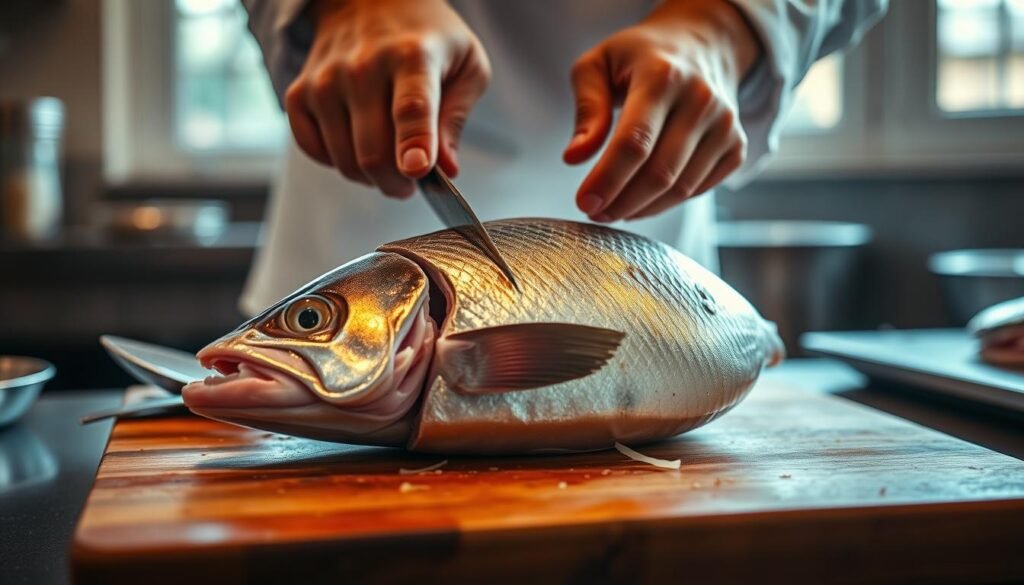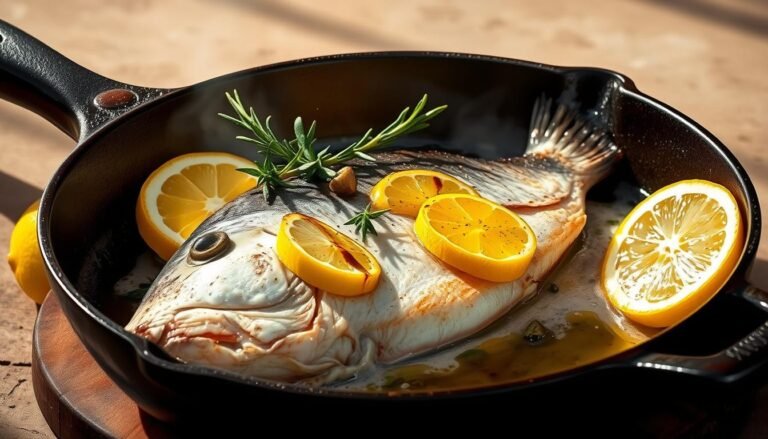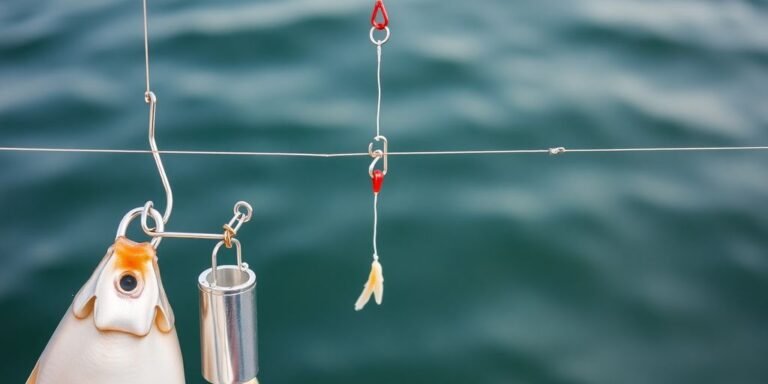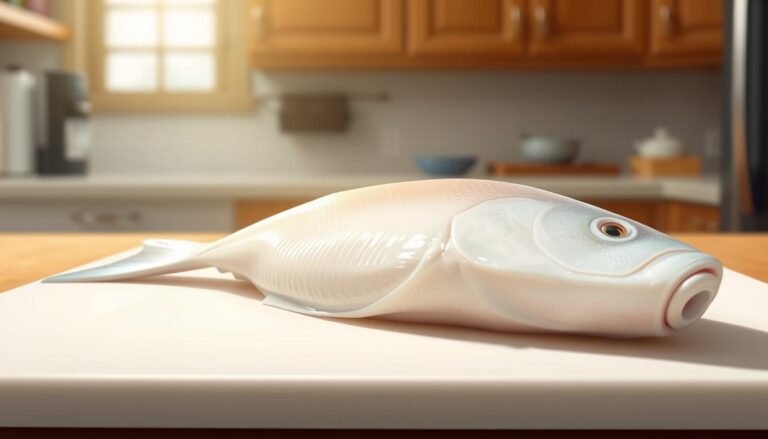Mastering the art of fish bone removal can be a game-changer for home cooks. Not only does it provide fantastically fresh fillets, but it also saves money and minimizes waste. Many people find the process intimidating, but with the right techniques and tools, it can be done safely and efficiently.
By learning how to prepare fish fillets at home, you can enjoy a more sustainable and cost-effective way of cooking. This article will guide you through the process, covering the essential techniques and tools required for a fillet cleaning guide.
Key Takeaways
- Learn the benefits of deboning fish at home, including cost savings and reduced waste.
- Discover the essential tools required for safe and efficient fish bone removal.
- Understand the techniques for preparing fresh fillets without ruining the flesh.
- Explore a step-by-step guide to fillet cleaning and preparation.
- Master the art of deboning fish with confidence and ease.
The Art and Science of Fish Deboning
Mastering fish deboning techniques is both an art and a science that requires precision and practice. Proper deboning is crucial for achieving high-quality fillets that are not only more pleasant to eat but also provide better value for money.
Why Proper Deboning Matters
Proper deboning yields a more pleasant meal as it ensures the removal of bones, making the fish safer and more enjoyable to consume. Moreover, clean filleting offers you the best value for your money by maximizing the usable flesh from your catch. Not deboning properly is essentially the wastage of food and money.
The Difference Between Professional and Amateur Results
Professional deboning results in clean, bone-free fillets that retain the delicate flavor and texture of the fish. In contrast, amateur deboning often leaves behind bones and can damage the flesh, reducing the overall quality of the fillet. By mastering fish deboning techniques, you can achieve professional results that enhance your culinary experience.
Understanding the importance of proper deboning and practicing the right techniques can significantly improve your skills in preparing fish for cooking. Whether you’re a seasoned angler or a culinary enthusiast, achieving professional results in fish deboning can elevate your dishes and provide a more satisfying dining experience.
Essential Tools for the Perfect Fillet
To achieve perfect fillets, Australian anglers need to arm themselves with the right gear. Deboning fish efficiently requires a combination of the right tools and techniques.
Selecting the Ideal Filleting Knife
A good filleting knife is thin, flexible, and razor-sharp. The flexibility allows the blade to bend along the contours of the fish bones, helping you stay close to the frame and minimizing wasted meat. When choosing a filleting knife, consider the type of fish you’ll be handling most often.
Must-Have Equipment for Australian Anglers
Apart from a quality filleting knife, Australian anglers should have:
- A cutting board with a non-slip surface
- A pair of kitchen shears for scaling and gutting
- Pliers or forceps for removing pin bones
Creating an Efficient Workspace
An efficient workspace is crucial for safe and effective fish deboning. Ensure your cutting area is clean, well-lit, and organized. A table or countertop of appropriate height can reduce fatigue during the deboning process.
| Tool | Purpose |
|---|---|
| Filleting Knife | Removing flesh from bones |
| Kitchen Shears | Scaling and gutting fish |
| Pliers/Forceps | Removing pin bones |
Understanding Australian Fish Anatomy
Understanding the anatomy of Australian fish is crucial for effective deboning. To master the art of filleting, one must first comprehend the basic structure of the fish they are working with.
Bone Structures in Common Aussie Fish
Most Australian fish, whether from saltwater or freshwater environments, have a similar basic skeletal structure. This includes the head, tail, spine, and rib bones that protect the internal organs. The delicious flesh, or fillets, lies on either side of the spine and ribs.

Differences Between Saltwater and Freshwater Species
Saltwater fish, such as snapper and barramundi, often have different bone densities compared to freshwater species like trout. Understanding these differences is key to successful deboning.
Identifying Key Bone Locations
To debone fish effectively, it’s essential to identify the location of key bones. The pin bones, for instance, run along the lateral line of many fish species and must be carefully removed to produce a boneless fillet.
Preparing Your Catch for Deboning
Before you start deboning your catch, it’s essential to prepare it properly to ensure the best results. Proper preparation involves several key steps that can significantly impact the quality of your fillets.
Proper Cleaning and Scaling Techniques
First, if your fish isn’t already scaled, do that now. Hold the fish firmly by the tail and scrape against the direction of the scales using a fish scaler or the back of a sturdy knife. This process not only removes scales but also helps in cleaning the fish.
After scaling, rinse the fish under cold running water to remove any remaining scales or debris. Pat the fish dry with paper towels, both inside and out, to remove excess moisture.
Optimal Fish Temperature for Deboning
The temperature of the fish is crucial for effective deboning. Ideally, the fish should be deboned when it’s chilled but not frozen. A temperature range between 0°C to 4°C (32°F to 39°F) is considered optimal as it firms up the flesh, making it easier to handle and debone.
Positioning for Maximum Yield
Proper positioning of the fish can significantly affect the yield and quality of the fillets. Place the fish on a stable, flat surface, and position it in a way that allows easy access to the belly and the backbone.
| Preparation Step | Importance | Tips |
|---|---|---|
| Scaling | Removes scales, improves cleanliness | Use a fish scaler or the back of a knife, scrape against scale direction |
| Cleaning | Removes debris, improves hygiene | Rinse under cold water, pat dry with paper towels |
| Temperature Control | Firms up flesh, eases deboning | Keep fish chilled (0°C to 4°C or 32°F to 39°F) |
By following these preparation steps, you can ensure that your fish is properly prepared for deboning, resulting in higher quality fillets and a more efficient process.
How to Debone Fish: The Complete Process
The key to successfully deboning fish lies in making the correct initial cuts and understanding fish anatomy. Deboning fish is a skill that, once mastered, can significantly enhance the quality of your seafood dishes.
Making Clean, Precise Initial Cuts
To begin the deboning process, lay the fish flat on a cutting board. Make a diagonal cut just behind the gills and pectoral fin down until you feel the knife hit the backbone. It’s crucial not to cut through the spine yet. This initial cut sets the stage for the rest of the deboning process.
Continue by making a cut along the spine, carefully separating the fillet from the bones. The goal is to make clean, precise cuts that minimize waste and preserve the integrity of the flesh.
Backbone Removal Techniques
Once you’ve made the initial cuts, the next step is to remove the backbone. This involves carefully prying the fillet away from the skeleton. For most fish, this can be done with a gentle touch and the right tools, such as a filleting knife or a pair of tweezers for more delicate areas.
The technique may vary slightly depending on the species of fish. For example, flat fish require a different approach compared to round fish. Understanding these differences is key to successful backbone removal.
The Art of Pin Bone Extraction
After removing the backbone, the next challenge is extracting the pin bones. These small bones can be tedious to remove, but it’s essential for a pleasant dining experience. Use a pair of tweezers or a pin bone remover to pull out the bones in the direction they are lying, being careful not to tear the surrounding flesh.
For larger fish, there may be more pin bones, requiring patience and precision. The reward is worth the effort: perfectly deboned fillets that are ready for cooking.
Mastering Round Fish Deboning
Deboning round fish requires precision and the right techniques to preserve the delicate flesh. Round fish, such as snapper, bream, and whiting, are popular catches among Australian anglers. Mastering their deboning can significantly enhance the dining experience.

Techniques for Snapper, Bream and Whiting
When deboning snapper, bream, and whiting, it’s essential to start with a sharp filleting knife. Make a clean cut along the spine, then carefully separate the fillet from the bones. For these species, using a gentle touch is crucial to avoid tearing the flesh.
- Make precise cuts to avoid damaging the fillet.
- Use a pair of tweezers or pliers to remove pin bones.
- Keep the fish cool to maintain flesh integrity.
Handling Barramundi and Murray Cod
Barramundi and Murray cod, being larger and more robust, require slightly different handling. For these species, it’s vital to remove the bloodline and dark meat to improve flavor and texture.
Key steps include:
- Scaling and gutting the fish properly before deboning.
- Making a precise cut behind the gills and along the belly.
- Carefully removing the backbone and pin bones.
Preserving Delicate Flesh During Deboning
To preserve the delicate flesh of round fish, it’s crucial to work in a cool environment and handle the fish gently. Using the right tools and techniques minimizes damage and ensures a high-quality fillet.
By mastering these techniques, anglers and chefs can significantly improve their filleting skills, resulting in better culinary experiences.
Flat Fish Deboning Strategies
Unlike round fish, flat fish deboning involves a different set of techniques that are crucial for maximizing fillet yield. Flat fish, such as flounder and flathead, have a unique anatomy that requires a tailored approach to deboning.
Working with Flounder and Flathead
When deboning flounder and flathead, it’s essential to start with a sharp filleting knife. The process begins with making a precise cut along the spine, carefully separating the fillet from the bones. Precision is key to avoid wasting flesh and to ensure the fillets remain intact.
John Dory and Other Challenging Species
John Dory, with its delicate flesh, presents a particular challenge. The key to deboning John Dory lies in gentle, precise movements, ensuring that the fillets are removed without damage. Other challenging species may require adjustments to technique, but the principle remains the same: precision and patience.
Maximizing Fillet Yield from Flat Fish
To maximize fillet yield, it’s crucial to understand the anatomy of the flat fish. By making informed cuts and using the right tools, anglers and chefs can significantly increase the amount of usable flesh. Here are some tips to achieve this:
- Use a sharp, flexible filleting knife.
- Make precise cuts along the bones.
- Keep the fish cool to prevent the flesh from becoming soft.
By following these strategies, individuals can improve their flat fish deboning skills, resulting in higher quality fillets and reduced waste.
Tackling Larger Australian Fish Species
Larger fish species, such as yellowfin tuna and kingfish, demand careful handling to minimize waste and maximize fillet yield. These fish present unique challenges due to their size and bone structure.
Deboning Yellowfin Tuna and Kingfish
When deboning yellowfin tuna and kingfish, it’s essential to start with a sharp filleting knife. The process begins with making a precise cut along the spine, taking care not to cut too deeply and damage the surrounding flesh. The key is to be patient and make smooth, even cuts. As noted by a seasoned angler, “The art of deboning lies in the subtlety of your movements and the sharpness of your knife.“
Techniques for Atlantic Salmon and Rainbow Trout
Atlantic salmon and rainbow trout, while smaller than some other larger fish species, still require careful deboning techniques. The process involves removing the pin bones first, followed by the backbone. Using the right tools, such as a pair of needle-nose pliers for pin bone removal, can make a significant difference. It’s also crucial to keep the fish cool to prevent the flesh from becoming soft and difficult to work with.
Managing Thick Bones and Heavy Scales
Managing thick bones and heavy scales is a critical aspect of deboning larger fish. For fish with particularly thick bones, using a sturdy filleting knife or even a bone saw may be necessary. The goal is to remove the bones without wasting too much of the surrounding flesh. As one expert advises, “
The secret to successful deboning is understanding the anatomy of the fish and adapting your technique accordingly.
“
By mastering these techniques, anglers can improve their efficiency and reduce waste when deboning larger Australian fish species.
Checking Your Work: Finding Hidden Bones
After deboning your fish, it’s crucial to inspect your work to ensure no hidden bones remain. This step is vital for guaranteeing a pleasant dining experience, as hidden bones can be a significant inconvenience.
Visual Inspection Techniques
A simple yet effective way to check for hidden bones is through a thorough visual inspection. Hold the fillet up to a light source and look for any shadows or slight protrusions that could indicate the presence of bones. This method is particularly effective for detecting larger bones.
The Fingertip Method for Detecting Bones
For smaller pin bones, the fingertip method is highly effective. Run your fingertips gently down the centerline of each fillet (from head end towards tail end). You’ll likely feel the small, sharp tips of the pin bones. This tactile approach can be more reliable than visual inspection alone.
Tools for Removing Stubborn Pin Bones
For removing detected pin bones, having the right tools is essential. Choosing the right knife can make a significant difference. Additionally, a pair of clean tweezers or pliers can be used to grip and remove pin bones. For a more professional approach, consider using a pin bone remover.
| Tool | Use | Effectiveness |
|---|---|---|
| Tweezers | Removing pin bones | High |
| Pliers | Gripping larger bones | Medium |
| Pin Bone Remover | Professional pin bone removal | Very High |
Safety First: Protecting Yourself and Your Catch
When deboning fish, safety should always be your top priority to prevent accidents and ensure the quality of your catch. Handling sharp knives and delicate fish flesh requires careful attention to avoid injuries and maintain the integrity of the seafood.
Preventing Knife Injuries
To prevent knife injuries, it’s essential to use the right technique and maintain focus. Always cut away from your body, and keep your fingers curled under and out of the way of the blade. A sharp knife is safer than a dull one because it requires less pressure and is less likely to slip.
Food Safety Considerations for Australian Seafood
Food safety is critical when handling seafood to prevent contamination and foodborne illnesses. Ensure that your workspace, tools, and hands are clean before starting. Store fish on ice if not processing immediately, and maintain a clean environment throughout the deboning process.
Proper Storage of Deboned Fillets
After deboning, store the fillets in a clean, covered container, and keep them refrigerated at a temperature below 4°C. For longer storage, consider freezing the fillets. Proper labeling and date tracking are also important for inventory management.
| Storage Method | Temperature | Duration |
|---|---|---|
| Refrigeration | Below 4°C | 1-2 days |
| Freezing | -18°C or lower | Several months |
Common Deboning Mistakes and How to Avoid Them
The key to successful deboning lies in understanding and avoiding common pitfalls. Deboning fish can be a delicate process, and even experienced anglers can make mistakes that lead to wasted fish and frustration.
Incorrect Knife Angles and Pressure
One of the most common deboning mistakes is using incorrect knife angles and pressure. Tearing the flesh often happens with a dull knife, using too much force, or pulling pin bones straight up. To avoid this, ensure your knife is sharp, use smooth slicing motions letting the knife do the work, and pull pin bones out at their natural angle.
Rushing Through Critical Steps
Rushing through the deboning process can lead to a multitude of mistakes, including torn flesh and leftover bones. Take your time and focus on making precise cuts. It’s better to take a few extra seconds to ensure a clean cut than to rush and risk damaging the fillet.
Salvaging Mistakes Without Wasting Fish
Even with mistakes, it’s often possible to salvage the fillet. The table below outlines common deboning mistakes and potential solutions:
| Mistake | Solution |
|---|---|
| Torn flesh | Use a sharp knife and smooth slicing motions |
| Leftover bones | Run your fingers over the fillet to detect bones, then remove them |
| Damaged fillet | Make precise cuts and avoid applying too much pressure |
By understanding and avoiding these common deboning mistakes, you can improve your filleting skills and enjoy a better yield from your catch.
Conclusion
Deboning fish is a skill that requires patience, practice, and the right techniques. With a sharp, flexible knife and a willingness to learn, you can create beautiful, boneless fillets and make delicious stock using the fish frame.
The techniques outlined in this fillet cleaning guide will help you to efficiently debone your catch, whether you’re working with round fish, flat fish, or larger species. By following these steps and practicing regularly, you’ll become more confident and proficient in deboning fish.
As you continue to hone your skills, remember that the key to successful deboning lies in making clean, precise cuts and taking your time to avoid wastage. With persistence and dedication, you’ll be able to enjoy perfectly deboned fish fillets and explore a world of culinary possibilities.





